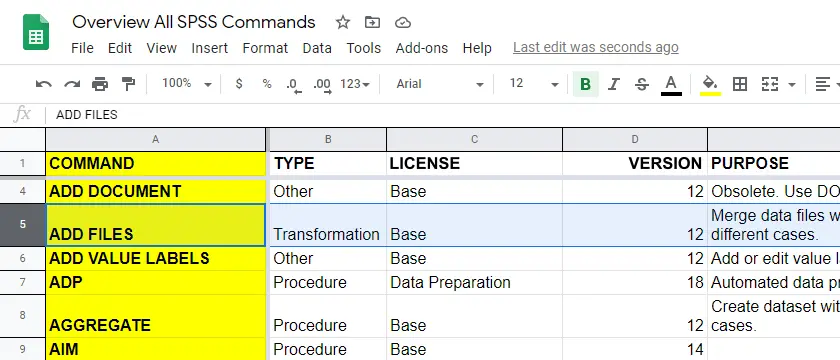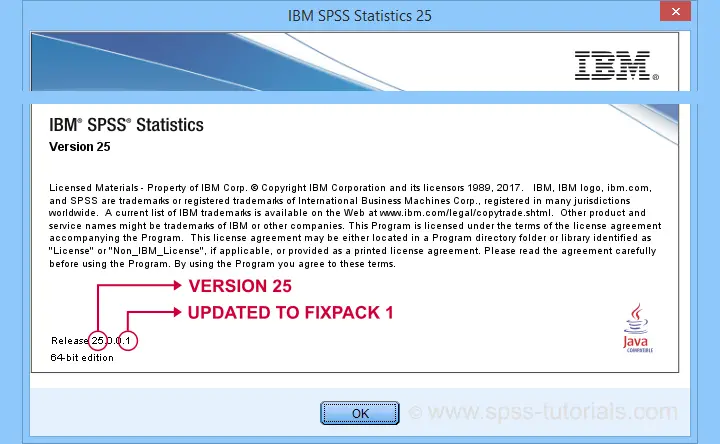A quick, simple and complete overview of all SPSS commands is presented in this Googlesheet, partly shown below.

For each command, our overview includes
Let's quickly walk through each of these components.
SPSS Command Types
SPSS commands come in 3 basic types:
- transformations are commands that are not immediately executed. Most transformations (IF, RECODE, COMPUTE, COUNT) are used for creating new variables. Transformations can be used in loops (DO REPEAT or LOOP) and/or conditionally (DO IF).
- procedures are commands that inspect all cases in the active dataset. Procedures are mostly used for data analysis such as running charts, tables and statistical tests. Procedures also cause transformations to be executed.
- other commands are neither transformations, nor procedures.

Required License
SPSS has a modular structure: you always need a base license, which you can expand with one or more licenses for additional modules.Very confusingly, modules are sometimes referred to as “options” in some documentation. Perhaps they will be referred to as “SPSS Apps” at some point in the future... The most useful modules are
- Advanced Statistics (repeated measures ANOVA, MANOVA and loglinear analysis);
- Regression (logistic regression);
- Missing Values (analysis of missing values and multiple imputation).
You can only use features from modules for which you're licensed. If you're not sure, running show license. prints a quick overview in your output window as shown below.

SPSS Versions
SPSS presents a new version roughly once a year. The latest version is SPSS 27, launched in May 2020. So which commands can you (not) use if you're on an older version? Look it up straight away in our overview.Quick note: commands that were introduced before SPSS 12 have been listed as version 12. We couldn't find any older documentation and we don't expect anybody to use such ancient versions anymore. Correct me if I'm wrong...
Not sure which SPSS version you're on?
Just run
show license.
and you'll find out. Alternatively, consulting
 also tells you which patches (“Fixpacks”) you've installed as shown below.I think this latter method is available only on Windows systems. I'm not sure about that as I avoid Apple like the plague.
also tells you which patches (“Fixpacks”) you've installed as shown below.I think this latter method is available only on Windows systems. I'm not sure about that as I avoid Apple like the plague.

Right. I hope you find my overview helpful. If you've any remarks or questions, please throw me a comments below.
Thanks for reading!
 SPSS TUTORIALS
SPSS TUTORIALS
THIS TUTORIAL HAS 2 COMMENTS:
By Jon Peck on December 7th, 2020
That’s a useful chart. I’ve always wished that the CSR entries had a Related Commands section.
Also, there is a new command called PROPORTIONS released with 27.0.1 that is not shown. It is unusual to add functionality in a fixpack, but this is nice to see. It’s relevant to your recent post on such functionality.
Another issue is that extension commands are not listed in the CSR but are only found via the Extension Hub menu. There are over 100 of these.
By Ruben Geert van den Berg on December 8th, 2020
Hi Jon, thanks for the feedback!
I'll try and update my SPSS 27 to look into the PROPORTIONS command and see if I can include it. Is it accessible from the menu too?
And do you -or anybody at IBM- have any insight into which extensions are downloaded how many times? Or any other user stats? Perhaps it would be nice to cover a top 5 or top 10 most useful SPSS extensions at some point. However, if I have to start off with 100(+) extensions, it'll take more time than I can spend on it.